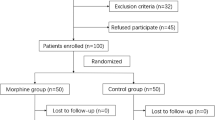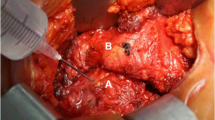Abstract
Purpose
Epidural and intravenous patient-controlled analgesia (PCA) are established methods for pain relief after total hip arthroplasty (THA). Periarticular infiltration is an alternative method that is gaining ground due to its simplicity and safety. Our study aims to assess the efficacy of periarticular infiltration in pain relief after THA.
Methods
Sixty-three patients undergoing THA under spinal anaesthesia were randomly assigned to receive postoperative analgesia with continuous epidural infusion with ropivacaine (epidural group), intraoperative periarticular infiltration with ropivacaine, clonidine, morphine, epinephrine and corticosteroids (infiltration group) or PCA with morphine (PCA group). PCA morphine provided rescue analgesia in all groups. We recorded morphine consumption, visual analog scale (VAS) scores at rest and movement, blood loss from wound drainage, mean arterial pressure (MAP) and adverse effects at 1, 6, 12, 24 h postoperatively.
Results
Morphine consumption at all time points, VAS scores at rest, 6, 12 and 24 h and at movement, 6 and 12 h postoperatively were lower in infiltration group compared to PCA group (p < 0.05), but did not differ between infiltration and epidural group. There was no difference in adverse events in all groups. At 24 h, MAP was higher in the PCA group (p < 0.05) and blood loss was lower in the infiltration group (p < 0.05).
Conclusions
In our study periarticular infiltration was clearly superior to PCA with morphine after THA, providing better pain relief and lower opioid consumption postoperatively. Infiltration seems to be equally effective to epidural analgesia without having the potential side effects of the latter.

Similar content being viewed by others
References
Skinner HB (2004) Multimodal acute pain management. Am J Orthop (Belle Mead NJ) 33(5 Suppl):5–9
Strassels SA, Chen C, Carr DB (2002) Postoperative analgesia: economics, resource use, and patient satisfaction in an urban teaching hospital. Anesth Analg 94:130–137
Frater RA, Moores MA, Parry P, Hanning CD (1989) Analgesia-induced respiratory depression: comparison of meptazinol and morphine in the postoperative period. Br J Anaesth 63:260–265
Tang R, Evans H, Chaput A, Klim C (2009) Multimodal analgesia for hip arthroplasty. Orthop Clin North Am 40:377–387
Newsome LT, Weller RS, Gerancher JC, Kutcher MA, Royster RL (2008) Coronary artery stents: II. Perioperative considerations and management. Anesth Analg 107:570–590
Hebl JR, Kopp SL, Ali MH, Horlocker TT, Dilger JA, Lennon RL et al (2005) A comprehensive anesthesia protocol that emphasizes peripheral nerve blockade for total knee and total hip arthroplasty. J Bone Joint Surg Am 87(Suppl 2):63–70
Essving P, Axelsson K, Kjellberg J, Wallgren O, Gupta A, Lundin A (2009) Reduced hospital stay, morphine consumption, and pain intensity with local infiltration analgesia after unicompartmental knee arthroplasty. Acta Orthop 80:213–219
Kerr DR, Kohan L (2008) Local infiltration analgesia: a technique for the control of acute postoperative pain following knee and hip surgery: a case study of 325 patients. Acta Orthop 79:174–183
Busch CA, Whitehouse MR, Shore BJ, MacDonald SJ, McCalden RW, Bourne RB (2010) The efficacy of periarticular multimodal drug infiltration in total hip arthroplasty. Clin Orthop Relat Res 468:2152–2159
Parvataneni HK, Ranawat AS, Ranawat CS (2007) The use of local periarticular injections in the management of postoperative pain after total hip and knee replacement: a multimodal approach. Instr Course Lect 56:125–131
Kardash KJ, Sarrazin F, Tessler MJ, Velly AM (2008) Single-dose dexamethasone reduces dynamic pain after total hip arthroplasty. Anesth Analg 106:1253–1257
Pratap JN, Shankar RK, Goroszeniuk T (2007) Co-injection of clonidine prolongs the anesthetic effect of lidocaine skin infiltration by a peripheral action. Anesth Analg 104:982–983
Kampe S, Randebrock G, Kiencke P, Hünseler U, Cranfield K, König DP, Diefenbach C (2001) Comparison of continuous epidural infusion of ropivacaine and sufentanil with intravenous patient-controlled analgesia after total hip replacement. Anaesthesia 56:1189–1193
Andersen LJ, Poulsen T, Krogh B, Nielsen T (2007) Postoperative analgesia in total hip arthroplasty: a randomized double-blinded, placebo-controlled study on peroperative and postoperative ropivacaine, ketorolac, and adrenaline wound infiltration. Acta Orthop 78:187–192
Gupta A, Bodin L, Holmstrom B, Berggren L (2001) A systematic review of the peripheral analgesic effects of intraarticular morphine. Anesth Analg 93:761–770
Parvataneni HK, Shah VP, Howard H, Cole N, Ranawat AS, Ranawat CS (2007) Controlling pain after total hip and knee arthroplasty using a multimodal protocol with local periarticular injections: a prospective randomized study. J Arthoplasty 22(Suppl 2):33–38
Lunn TH, Kristensen BB, Andersen LØ, Husted H, Otte KS, Gaarn-Larsen L, Kehlet H (2011) Effect of high-dose preoperative methylprednisolone on pain and recovery after total knee arthroplasty: a randomized, placebo-controlled trial. Br J Anaesth 106:230–238
Essving P, Axelsson K, Kjellberg J, Wallgren O, Gupta A, Lundin A (2010) Reduced morphine consumption and pain intensity with local infiltration analgesia (LIA) following total knee arthroplasty. Acta Orthop 81:354–360
Meunier A, Aspenberg P (2006) Parecoxib impairs early metaphyseal bone healing in rats. Arch Orthop Trauma Surg 126:433–436
McCartney CJ, Duggan E, Apatu E (2007) Should we add clonidine to local anesthetic for peripheral nerve blockade? A qualitative systematic review of the literature. Reg Anesth Pain Med 32:330–338
Casati A, Magistris L, Fanelli G, Beccaria P, Cappelleri G, Aldegheri G, Torri G (2000) Small-dose clonidine prolongs postoperative analgesia after sciatic-femoral nerve block with 0.75% ropivacaine for foot surgery. Anesth Analg 91:388–392
Brill S, Plaza M (2004) Non-narcotic adjuvants may improve the duration and quality of analgesia after knee arthroscopy: a brief review. Can J Anaesth 51:975–978
Eisenach JC, De Kock M, Klimscha W (1996) alpha(2)-adrenergic agonists for regional anesthesia. A clinical review of clonidine (1984–1995). Anesthesiology 85:655–674
Andersen KV, Pfeiffer-Jensen M, Haraldsted V, Søballe K (2007) Reduced hospital stay and narcotic consumption, and improved mobilization with local and intraarticular infiltration after hip arthroplasty: a randomized clinical trial of an intraarticular technique versus epidural infusion in 80 patients. Acta Orthop 78:180–186
Padala PR, Rouholamin E, Mehta RL (2004) The role of drains and tourniquets in primary total knee replacement: a comparative study of TKR performed with drains and tourniquet versus no drains and adrenaline and saline infiltration. J Knee Surg 17:24–27
Author information
Authors and Affiliations
Corresponding author
Rights and permissions
About this article
Cite this article
Pandazi, A., Kanellopoulos, I., Kalimeris, K. et al. Periarticular infiltration for pain relief after total hip arthroplasty: a comparison with epidural and PCA analgesia. Arch Orthop Trauma Surg 133, 1607–1612 (2013). https://doi.org/10.1007/s00402-013-1849-8
Received:
Published:
Issue Date:
DOI: https://doi.org/10.1007/s00402-013-1849-8




